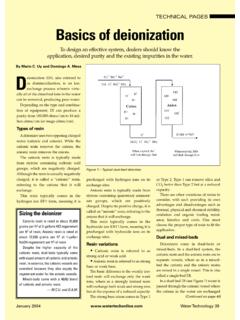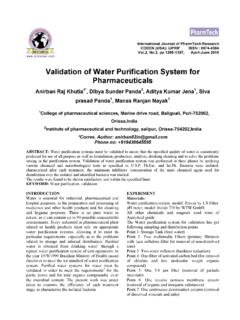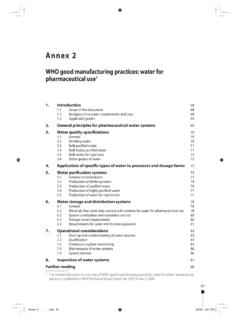Transcription of Capacitive deionization final - AQWATEC
1 Capacitive deionization & Electronic Water Purifier Capacitive deionization (CDI) is an emerging water treatment technology that uses electrophoretic driving forces to achieve desalination. During CDI, ions are adsorbed onto the surface of porous electrodes by applying a low voltage ( VDC) electric field. The negative electrodes attract positively charged ions such as calcium, magnesium, and sodium; simultaneously, the positive electrodes attract negatively charged ions such as chloride, nitrate and sulfate. Unlike ion exchange processes, no additional chemicals are required for regeneration of the electrosorbent in this system. Eliminating the electric field allows ions to desorb from the surface of the electrodes and regenerates the electrodes. There are a variety of electrode materials and configurations to enhance performance.
2 Optimized carbon aerogel is an ideal electrode material because of its high electrical conductivity, high specific surface area, and controllable pore size distribution. Previous studies show that CDI technology is cost competitive with reverse osmosis processes only at a low feed TDS concentration range (<3,000 mg/L) due to the high cost of CDI modules with increased feed water TDS concentrations. During laboratory and field treatment of sandstone-produced water with a commercial CDI system (Electronic Water Purifier (EWP)), no electrode deterioration was observed and the CDI process exhibited much less fouling/scaling propensity compared to RO/NF. Summary of technical assessment of CDI Criteria Description/Rationale Status of technology Emerging technology. Have been pilot tested in Atlantic Rim for CBM produced water treatment 10,000 gal/day (250 bbl/day).
3 Feed water quality bins Cost competitive for water with TDS <3,000 mg/L, and can be applied to water with TDS<6,000 mg/L. CDI is applicable to all types of water chemistry makeup. Product water quality Product water quality depends on treatment time. EWP can achieve 90% TDS removal. CDI has poor removal of uncharged chemical species such as boron and organics. Recovery Product water recovery is approximately 80%. Energy use The power consumption of CDI depends on the amount of salt removed. For example, to achieve 88-89% removal, the energy consumption of EWP is 4 kWh/kgal ( kWh/bbl) for 2,500 mg/L TDS feed water, and 18 kWh/kgal ( kWh/bbl) for 6,000 mg/L TDS water. Summary of technical assessment of CDI Criteria Description/Rationale Chemical use No chemicals required. Expected lifetime of critical components 10 years Infrastructure considerations These systems are mobile and have a small footprint O&M considerations Low levels of monitoring and control.
4 Low level of skilled labor required. High level of flexibility. High level of robustness High level of reliability Types of energy required: electricity or gas. Can be run by 3 KW diesel generator or propane generator. Capital and O&M costs Over a 10-year period, the total capital and O&M costs is estimated to be $ per barrel of water processed. Pretreatment of feed water Minimal pretreatment (cartridge filter) is needed. Post-treatment of product water Not required Concentrate management or waste disposal 20% brine needs deep well injection or crystallizer for ZLD, and generated solids need waste disposal. Additional water recovery can be achieved with other desalination processes. Status of technology Good for treatment of produced water with TDS<3,000 mg/L. Note: 1 barrel = 42 US gallon




